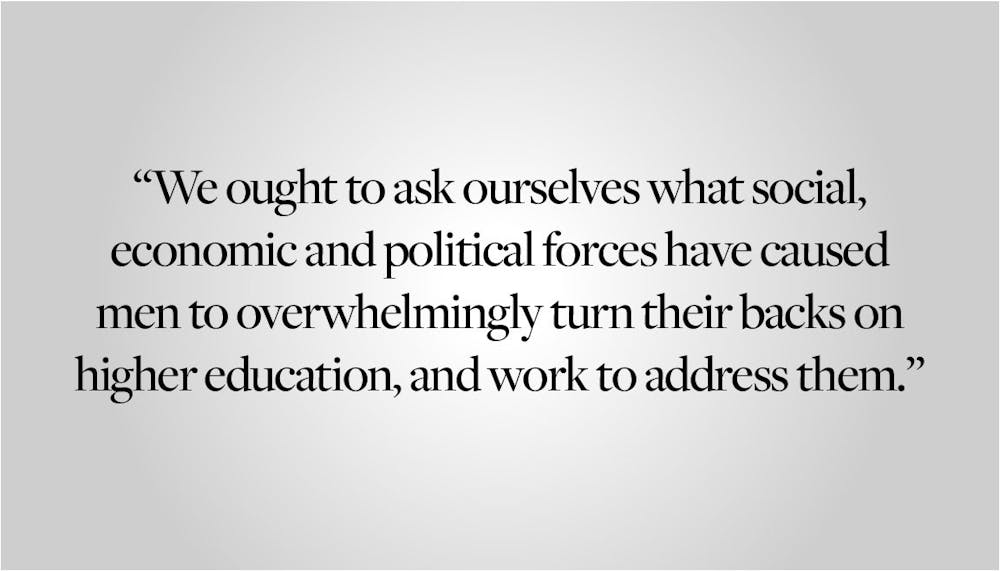Today’s higher education landscape looks drastically different from that of our parents. In a dramatic reversal of the United States’ higher education gender breakdown, 59.5% of college students today are women. While both men and women this century are more likely to attend college than in the past, the pace of enrollment for men has been comparatively slower. If current trends continue, we can soon expect to graduate two women for every man receiving a college degree. At Brown, one might fail to notice this trend because, like its peers, the University extends an implicit boost to male applicants in order to keep an even gender ratio. However, like any demographic disparity, this has consequences. We ought to ask ourselves what social, economic and political forces have caused men to overwhelmingly turn their backs on higher education, and work to address them.
For the past two years, I have served as a volunteer tutor at the Downtown Boxing Gym, a free youth program in inner-city Detroit. Among my male students, I have seen a general disengagement with education that only grows as they progress through the years. In contrast, my female students are more focused and stay out of trouble, and many go on to attend university. My experience tutoring is reflected in national trends: Of the 700,000-student drop in undergraduate enrollment during the COVID-19 pandemic, 78% can be attributed to male students leaving college. What’s going on?
We know that college is one of the most significant investments a young person can make in their lifetime. I fear that if men continue to leave college behind, society will leave them behind in return, and this will have wide-reaching adverse effects. In a 2018 study, economists at Stanford University, Harvard and the U.S. Census Bureau found that income inequality between Black and white Americans is driven by differing rates of downward social mobility of men. Furthermore, economic deprivation has been linked to higher levels of incarceration. Thus, increasing access to education may help break cycles of lack of economic opportunity. Additionally, America’s gendered educational divide only exacerbates preexisting polarities in American culture, since women and college graduates are more likely to vote Democratic, combining to result in college becoming seen as not only partisan but also gendered.
As we continue to shift to a more knowledge-based economy, in which traditionally masculine physical labor becomes less valued, we ought to change our approach to encourage more men, especially those who are economically disadvantaged, to seek higher education. One science-backed solution may be to simply have boys, in certain circumstances, start school a year later. Neuroscientists have long known that the brains of boys and girls mature at different rates: Girls are more likely to be school-ready at age 5 when controlling for parental characteristics. Delaying school starts yields improvements in many academic outcomes, especially for boys and low-income students. Furthermore, it is imperative that state and federal lawmakers implement programs to encourage men to become teachers, as research shows that boys especially benefit from male mentorship, particularly boys of color. In fact, a study in Finland showed that boys taught by male instructors were more likely to attend college, and girls taught by male instructors were more likely to study technical fields. At the collegiate level, schools ought to reach out to and create spaces for male students, especially low-income students and students of color. Some smaller colleges have even opted to create football teams to boost lagging male enrollment numbers.
On a broader societal scale, we need to reframe the conversation around masculinity. In some communities, academically inclined men, especially working-class ones, might be seen as queer or feminine, or believe that a man’s place lies in physical labor. This deeply simplistic worldview holds them back and results in sisters getting ahead educationally while brothers are left behind. Part of this phenomenon stems from a lack of male cultural icons closely associated with the value of higher education — ones that compete with household names like Malala Yousafzai and Brown alum Emma Watson ’14. Such icons could channel an “Obama Effect” — a boost to academic outcomes from seeing a role model who looks like you — motivating young men to pursue education and aim higher.
While to some it may seem problematic to focus an entire column on aiding an already privileged group, I counter that suffering anywhere merits our full attention. The future of boys is the future of our brothers and our sons, and that future deserves to be bright.
Tas Rahman ’26 can be reached at tasawwar_rahman@brown.edu. Please send responses to this opinion to letters@browndailyherald.com and other op-eds to opinions@browndailyherald.com.

Tas Rahman is an opinions editor at the Brown Daily Herald writing about issues in higher education. When he's not coding or studying biochemistry, you can find him hiking and enjoying the great outdoors.





